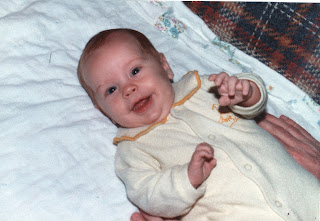Happy New Year! Today I'm sharing a post written by my brother, Eric Evenson, about his trip to Norway to learn about Otto Evenson's home and early years.
Searching for Scandinavian Roots by Eric Evenson
I have always been intrigued with the life story of my grandfather, Otto Evenson, who emigrated to the U.S. from Norway at the age of 15. Karen Eastlund has blogged about Otto and his restaurant. I was lucky enough to go to Norway to see where Otto lived and learn a little about his life there. This post will share some of that journey with you.
Otto was born in 1870 and immigrated to Minnesota in 1885. He was 84 when I was born, and I was 16 when he died. We visited my grandparents several times a year, but I never asked him about his youth. However, since I’m the youngest of ten children, I heard stories about Otto from older siblings. We knew the region of Norway that he came from, and we had contact with some distant relatives in Norway who had done some genealogy tracing.
In 2006 my oldest brother, Emil Jr., invited my wife, Karen Fell Evenson, and I to join him and his wife Judy on a trip to Norway. Emil is 25 years older than I and he and Judy had previously visited Norway, so they were experienced and welcome guides for us. Our plans included seeking Otto’s home and church.
After some initial stops in Norway, we made an easy drive from Lillehammer to the Toten District to meet Ole Grannum, our relative and guide to my grandpa’s original stomping grounds. Ole arranged to meet us at an auto service plaza in Gjovik, Norway. I expected a little station with one or two pumps, but it turned out to be a major truck stop, so while Emil, Judy, and Karen stretched their legs, I was sent to find Ole. I wondered how I would find someone I had never met, but halfway around the perimeter Ole walked up to me and said, “You must be Eric. You look just like all the Evensons.” I was both shocked and happy. Ole joined the group, renewed his acquaintance with Emil, and we got underway.
Left to right: Eric, Ole Grannum, and Emil Jr.
Our first stop was the Hoff kirke, or Hoff Church, about 2 km northeast of the small town of Lena. This was the church that my Grandpa Otto attended, along with ancestors before him. He was baptized and confirmed at this church. It was so cool visiting this place that I can barely contain myself now in telling you about it. You can read about this church here.
The Hoff Church
Door of the Hoff Church
We walked through the graveyard and talked about the customs of the day. My ancestors would not have been buried in the church cemetery since they were not landowners. The Stabo family, who owned the farm where my great grandfather worked and lived, were buried there however, and we found their graves. We don’t know where my relatives were buried. By 1884, my great grandparents did eventually amass enough funds to buy a small acreage called Evenstad. That would have been about the time that Otto was confirmed in the church, and just a year before he left for the U.S.
Inside the church the architecture was amazing. The altarpiece is dated 1664 and the baptismal font 1703. The same one that my grandpa and his siblings were baptized in! If you look closely, you can see that the font is held up by an angel with a dolphin peeking between his feet. On the walls was a gallery of all the pastors who served the church beginning in 1401… well before Luther’s reformation.
Baptismal Font from 170 Altarpiece from 1664
The Stabo Farm is a mile and a half west of the Hoff Church and a mile north of the town square in Lena. That is where Otto’s parents, my great-grandparents, Even Jacobsen Fodstad and Helene Hansdatter Sundbye, lived and worked during Otto’s childhood. They were hearty people, raising eight children while they worked on the farm. They probably walked to church for religious and social events. Helene lived to be 101. It was here that Otto learned to play the accordion well enough that his older brothers took him to surrounding towns and farms to play for dances.
Photo Even J Fodstad and Helene H. Sundbye, my great grandparents
The farm is down a tree-lined lane directly off Slettavegen, a main road going into Lena. The farm has a white farmhouse centrally located in a ring of stables, barns and outbuildings.
On the front lawn of the Stabo farmhouse was a stone obelisk, all wrapped in plastic. Ole Grannum explained that it was a rune stone which local universities were studying and preparing to transport to a museum. The stone is dated to the ninth century. Cool!
Photo Eric & Emil at side of the Stabo farmhouse
It was somewhat of a shock, however, to learn that my family did not live in the farmhouse. My great grandparents and their children lived across the farmyard in a building which included living quarters for hired help, stables for animals, and occasionally was used as a jail. Humbling news! I couldn’t help but wonder what it was like for Otto to live next to prisoners awaiting trial.
Eric & Emil in front of Otto’s living quarters
I was struck by the austere life that they must have led, concurrent with the post-Civil War era in the U.S. At that time, Norway was ruled by Sweden. Emigration from Norway to North America started in 1825 with the first mass emigration in the 1860s. That was about when Otto’s older brothers started thinking of leaving Norway. No doubt they heard of a better life here, with the potential for property ownership.
A main takeaway from my visit to Stabo Farm and the Lena area is this: If your name is Evenson and your ancestors came from Spring Grove, MN, and you’ve been tempted to buy a Family Crest of Coat of Arms, save your money! I can confidently tell you that we do not come from royalty. The only coats our ancestors had were to save them from hypothermia. We come from humble stock, but I found many reasons to be proud of them. They were bold, sturdy, religious, hard-working, musical, and blessed with longevity. That is enough for me.
I am grateful for the opportunity to visit the Norwegian branch of my family and absorb the culture and history my Grandpa Otto grew up in. I’m glad Emil Jr. suggested the trip, and I’m happy I met Ole Grannum and learned some of our history straight from him. And I’m thankful that Grandpa Otto got on that ship at age 15 to come to the United States to start a new life.




































